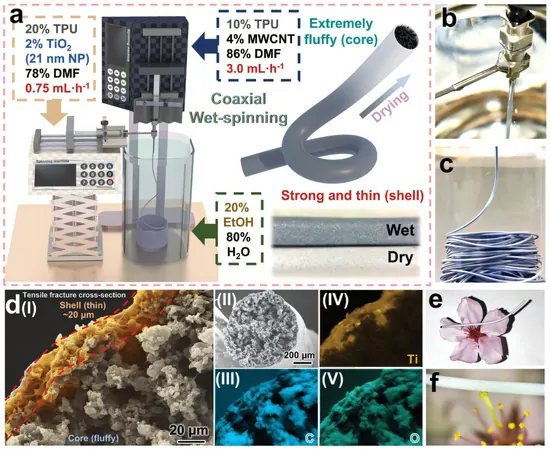
Revolutionary DNA-Inspired Fiber Sensors Transform Wearable Technology
2025-04-28
Author: Jacob
A Breakthrough in Wearable Sensors
Researchers at Shinshu University have unveiled a groundbreaking fiber sensor inspired by the double helix structure of DNA. This innovative design promises to redefine durability and flexibility in wearable technology, tackling significant limitations that traditional sensors encounter.
Say Goodbye to Sensor Failures!
Traditional fiber sensors often feature electrodes at both ends, making them susceptible to breaking when subjected to the repetitive movements common around body joints. However, this new double-helical innovation cleverly places both electrodes at one end, allowing the sensor to endure extensive stretching and bending—solving a major problem in wearable design.
Why Flexibility Matters in Wearables
Wearable sensors are essential components of smart devices, valued for their lightweight and compact nature. Yet, mechanical challenges have limited the application of existing designs, particularly in high-movement areas like fingers and knees. The strategy employed by Shinshu's researchers is set to shift the narrative.
Crafted for Stability and Performance
In their design, inspired by the stability of DNA, the researchers intertwined two coaxial fibers into a tightly bound structure. This approach significantly enhances the performance and lifespan of wearable sensors. According to Associate Professor Chunhong Zhu, the electrode design is pivotal: "Our design directly tackles long-standing challenges in one-dimensional fiber sensors."
Unveiling the TT/MT Dual-Helical Fiber Sensor
Each fiber is created through coaxial wet-spinning, combining a fluffy inner core made of multi-walled carbon nanotubes (MWCNTs) with a durable outer layer of thermoplastic polyurethane (TPU) and titanium dioxide (TiO2) nanoparticles. This process leads to a slender, robust TT/MT dual-helical fiber sensor that measures under 1 mm in diameter.
Endurance Tested to Perfection
Laboratory tests revealed that this new fiber sensor withstands over 1,000 stretching cycles, stretching more than 300% beyond its original size without damage. Such resilience opens doors for diverse applications, including gesture tracking and real-time monitoring.
Empowering the Future of Interaction
In exciting trials, the sensor was embedded in a glove, accurately detecting six hand gestures with a stunning 98.8% accuracy using a machine-learning model. This capability not only showcases potential benefits for everyday users but also positions the technology as a crucial aid for individuals with disabilities.
Next-Gen Smart Fabrics: The Vision Ahead
The researchers believe that this design could revolutionize Bluetooth-connected wearables, enabling versatile applications in rehabilitation and sports training. Imagining a future where these sensors are embedded in clothing worn during extreme activities, they could send real-time alerts in emergencies.
Inspiring Intelligent Fiber Innovations
With their groundbreaking TT/MT dual-helical fiber sensor, researchers aim to inspire the next generation of intelligent, durable fibers that seamlessly integrate into our daily lives. As Dr. Zhu puts it, this versatile approach could spark a wave of tailored intelligent fibers for an array of applications.









 Brasil (PT)
Brasil (PT)
 Canada (EN)
Canada (EN)
 Chile (ES)
Chile (ES)
 Česko (CS)
Česko (CS)
 대한민국 (KO)
대한민국 (KO)
 España (ES)
España (ES)
 France (FR)
France (FR)
 Hong Kong (EN)
Hong Kong (EN)
 Italia (IT)
Italia (IT)
 日本 (JA)
日本 (JA)
 Magyarország (HU)
Magyarország (HU)
 Norge (NO)
Norge (NO)
 Polska (PL)
Polska (PL)
 Schweiz (DE)
Schweiz (DE)
 Singapore (EN)
Singapore (EN)
 Sverige (SV)
Sverige (SV)
 Suomi (FI)
Suomi (FI)
 Türkiye (TR)
Türkiye (TR)
 الإمارات العربية المتحدة (AR)
الإمارات العربية المتحدة (AR)